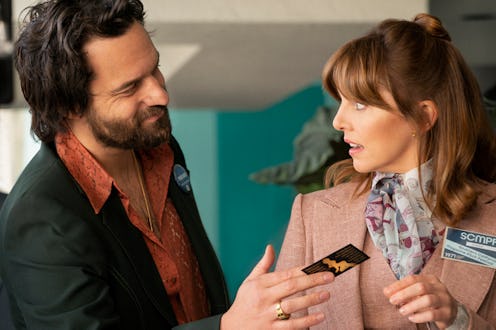Streaming
Inside The Erotic Magazines That Inspired HBO Max’s Minx
The new comedy follows a young feminist who teams up with a low-rent publisher to create the first erotic magazine for women.

You can expect to see a lot of dicks on HBO Max’s Minx. Set in 1970s Los Angeles, the “feminist porn comedy” centers around Joyce (Ophelia Lovibond), an earnest young feminist who joins forces with a low-rent publisher (Jake Johnson) to create the first erotic magazine for women. That naturally means a lot of full-frontal male nudity. “The way male nudity is used is really gratuitous and I don’t have a problem with that,” Minx creator Ellen Rapoport told The Hollywood Reporter, joking that she wanted the show to include as many penises as possible. “I wanted to go tit for tat so women would be able to see men naked.”
Rapoport explained that Minx was inspired by real magazines like Playgirl and Viva. “I read something about one of these magazines and it struck me immediately: these magazines in the 1970s were feminist magazines,” she said. “It was a workplace that was populated by feminists and pornographers.”
Per Shondaland, erotic women’s magazines rose in popularly in the early 1970s, when second wave feminism was in full swing and women won the rights to use birth control and get legal abortions. At the same time, the sexual revolution was happening, and many people were coming to terms with the idea that women could be smart and horny. “[We recognized] that women were interested in men, that women were interested in sex, and that women also had minds,” Viva contributor Annie Gottlieb told the outlet.
Viva was started in 1973. It featured sexy nude centerfolds and humorous columns like "Crotch Watching,” which were just shots of men’s clothed crotches in different outfits. But it also published pieces about consent and sexual assault, interviews with prominent women like Maya Angelou, book reviews by accomplished critics, and fashion, lifestyle, and astrology pieces. It was owned by Penthouse owner and media mogul Bob Guccione, but largely run by his business and life partner Kathy Keeton.
“They staffed the first issue with men, mostly, but they quickly realized, 'This isn't gonna work, a magazine for women run by men.' And so we took over,” Viva’s editorial director Alma Moore told Shondaland. Many of the women at Viva had written for newspapers and magazines like The New York Times and Newsweek. Among the notable contributors were Gail Sheehy and Maxine Hong Kingston. Anna Wintour was even an editor.
Though Viva was boundary-breaking for its time, it struggled to differentiate eroticism from pornography. “They could've done better with the male nudes, made them more attractive from a woman's point of view,” Gottlieb admitted. Viva never quite found its identity as being a raunchier Ms., and its contents made it both a hard sell for advertisers and an unlikely purchase for women, who were embarrassed to buy it at the newsstand. The business faltered, and Viva ran its last issue in January 1979.
Playgirl launched in 1973 with a similar mission statement as Viva: print male nudes alongside articles for women. It also ran interviews with prominent feminists and published stories about issues like marital rape. It was wildly successful in the 1970s, and its print version lasted until 2009. But it was also largely run by men, who were in denial that the people purchasing their magazine were actually gay men rather than women.
“They tried to hire me to edit Playgirl in 1991 and again a few years later,” writer Dian Hanson told Esquire. “The guys who ran the magazine, asked, ‘OK, what would you do to make girls buy Playgirl?’ I said, ‘It would be easier to make this magazine work better than it already does for gay men.’ They looked at me in horror and said, ‘Men don't buy this magazine! We don't want to make a magazine for men to jack off to!’ But…they already did.”
The magazine stopped printing in 2009 and was briefly brought back in 2010 before being bought by a porn publishing company in 2011. Today, Playgirl.com is largely targeted toward gay readers. “We'd seen the issues from [Playgirl’s] heyday in the ‘70s. That was the magazine we wanted to work for,” 2002 editor-in-chief Jill Sieracki said. “There were these great, smart, strong women who wrote for the magazine back in the day…We were owned by men; none of them were on board with a feminist.”
This article was originally published on